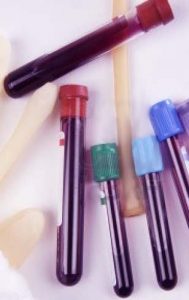Ron Hines DVM PhD
 See What Normal Blood & Urine Values Are
See What Normal Blood & Urine Values Are
 Causes Of Most Abnormal Blood & Urine Tests
Causes Of Most Abnormal Blood & Urine Tests
Your Dog Or Cat’s Total Blood Protein Level = TP
The amount of protein circulating in your dog or cat’s blood serum tells your veterinarian many things. For one, it can be a clue as to how well your dog or cat is hydrated. It can also tell your veterinarian a lot about how well your dog or cat’s liver and kidneys are functioning. When veterinarians do calculations to arrive at the amount of albumen protein within the total protein portion of your pet’s blood and subtracted that from the total protein (TP) value, it gives us your pet’s blood globulin protein level. Low or high blood globulin can alert your veterinarian to issues like chronic inflammation or to infectious disease that may be present somewhere in the cat or dog’s body.
Your dog or cat blood contains numerous other dissolved specialized proteins, but in much smaller amounts. Some of these proteins transport vital nutrients to cells. Others function as hormones or antibodies that protect against disease. But the majority (~55%) of your pet’s blood protein is albumin – the same protein that makes up much of the egg whites you eat. Albumin is manufactured by your pet’s liver. It helps keep your pet’s blood pH in a narrow optimal range, Albumin binds to many hormones allowing them to circulate throughout the body, and it helps keep fluids in their proper location or compartment (the osmotic effect).
When your dog or cat is severely deficient in total blood protein, fluid will leak into the space surrounding its lungs (pleural effusion) and/or surrounding its abdominal organs (ascites). Respectively, that causes difficulty breathing or a potbelly.
The next most prevalent proteins in your pet’s blood that forms part of the TP are globulins (~38%). Some globulin is produced in your pet’s liver and some (the immunoglobulins or antibodies) are manufactured by portions of your pet’s immune system (their lymphoid tissue).
The third most prevalent blood protein included in a total protein/TP blood assay is fibrinogen. Fibrinogen (about 5% of TP) has the ability to convert to fibrin – a necessary material for your pet’s blood clotting process to be successful in the event of an injury. If the analysis laboratory is checking your pet’s blood serum after the blood sample has clotted (a red top tube), fibrinogen will not be included in your pet’s total protein level (it is all in the clot at the bottom of the test tube). If the test was performed on whole blood plasma (a purple top tube) the TP number will be a bit higher because the fibrinogen will still be dispersed in the blood sample.
Since blood protein is mostly a combination of albumin and globulin, two different groups of health issues will make your pet’s TP level go up or down. One relates to the amount and fate of the albumin (and certain globulins) produced by your pet’s liver and the other group of health issues relate to your dog or cat’s immune system and its ability to produce antibodies, another source of the globulin in blood.
Reasons Why Your Cat Or Dog’s Total Protein (TP) Level Might Be High:
Though not a disease, the most common reason a pet’s TP level might be elevated is dehydration. That could be due to a failure to drink, chronic diarrhea, persistent vomiting or perhaps a prolonged fever.
The second most common reason for high total protein is stimulation of your pet’s immune system to make globulin-containing antibodies to fight disease. Infections and chronic inflammations are the most likely underlying causes.
TP could be elevated for another non-infectious cause. Certain tumors of a pet’s bone marrow and lymphoid tissue tissue raise blood globulin levels as well (monoclonal gammopathies).
Most veterinary blood chemistry determinations report immune globulin values separately from total protein – although your dog and cat’s TP value includes globulin as well.
Elevated TP is quite common in cats that are suffering from FIP. It can also occurs when tick-borne blood parasites such as ehrlichia have infected your dog or haemobartonella (aka Mycoplasma haemofelis) carried by fleas is present in your cat. (read here) Total protein blood levels can also increase in cases of autoimmune diseases (“lupus“) in dogs and cats.
Reasons Why Your Dog Or Cat’s Total Protein (TP) Level Might Be Low:
Just as for abnormally high total protein levels, abnormally low TP values can be due to either a low blood albumin level or a low blood globulin level or both.
A common cause in younger dogs is heavy hookworm infection and the blood loss they cause. Heavy flea/Tick infestations in puppies and kittens is another cause. Starvation and protein deprivation is another common cause.
In mature pets, chronic intestinal inflammation (protein-loosing enteropathies), such as IBD in your dog or in your cat, certain food sensitivities (malabsorption syndromes) or pre-lymphoma states (primarily in cats) will also allow blood proteins to leak out of the body through damaged intestinal linings.
Pet with extensive liver damage no longer have the ability to manufacture sufficient albumen. So, their TP levels are usually low.
Cats with a common form of combined pancreatic, gall bladder, liver and intestinal problems (triad disease/ aka cholangiohepatitis) also tend to have low TP levels.
Pets with failing kidneys often leak large amounts of protein into their urine. Urinalysis and a urine microalbuminuria test detect that blood protein leakage when it is occurring.
Blood protein can also be lost when it is incorporated in abnormal fluids that sometimes pool in the chest (pleural effusions) and abdomen (ascites) of dogs and cats in congestive heart failure. It is probably also due to poor circulation within their livers where albumin and some globulins are made.
Losses of large amounts of blood due to trauma can also deplete your dog and cat’s blood protein stores, although pets without pre-existing health issues have the capacity to rapidly replace albumin and globulin.
Total protein level can also drop in acute infections and inflammation when those issues cause chemicals called cytokines to be released into the dog or cat’s circulation (a negative acute phase response).
Loss of large amounts of blood serum containing albumen and globulins through burns, and extensive skin infections (such as sarcoptic mange) can also lower TP. In demodectic mange, it is the globulin portion that might be low.
Puppies and kittens tend to naturally have somewhat lower TP levels because they are not yet capable of producing globulin antibodies at the level that mature pets do.
All the causes I listed for low blood albumin level will also cause low TP levels.
Total blood protein is naturally lower in greyhounds and possibly other sight hounds (4.5-6.2 vs 5.4-7.8) (read here).
Complementary Tests:
CBC/ WBC and blood chemistry values, serum protein electrophoresis (for hyperglobulinemia), urine protein electrophoresis, radial immunodiffusion for IgG, IgA and IgM (canine) (for suspected immunodeficiency and classification of myelomas), pancreatic function tests, TLI, vitamin B12 level / blood folate level, blood test for intestinal leakage problems, fecal exam for parasites
DxMe



